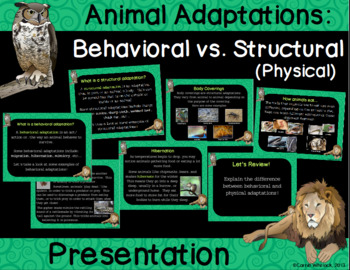Animal Adaptations : Structural Vs. Behavioral Presentation (Distance Learning)
- PDF
Also included in
- This bundle includes all of my current products (as of 5/10/2024) on Animal Adaptations. This includes presentations on inherited adaptations vs. learned adaptations, structural vs. behavioral adaptations, sorting activities, and assessments.Please see each individual product for more detailed inforPrice $10.48Original Price $13.10Save $2.62
Description
This Animal Adaptations: Structural Adaptations ( Physical Adaptations) Vs. Behavioral Adaptations Presentation is intended to help you explain the difference between structural (physical) and behavioral adaptations, and to provide examples of each. There are also review questions at the end that can be done as a class to review what they learned.
Presentation Topics:
*What is an adaptation?
*What is a structural adaptation? (Slide explaining structural = physical)
* Examples of structural adaptations:
- body coverings
- eating (teeth, beaks, baleen, etc...)
- internal structural adaptations (gills, lateral lines, hollow bones)
*What is a behavioral adaptation?
*Examples of behavioral adaptations:
- hibernation
- migration
- mimicry
*Review on structural vs. behavioral
**Please note that this presentation is in a PDF format to make sure you receive the file as intended. The fonts and pictures are protected this way, so you don't get any "funky" font issues! It plays just like a PPT file if you go to "View" and "Full Screen." It advances the slides just like a PPT file, and even works with a remote if you use one!
This presentation may be posted to password protected sites for your own class, like your class' Google Classroom, Edmodo, etc... Please refrain from posting it on non-password protected class sites (like Weebly, Blogger, district sites, etc...).
Please note that this presentation does not discuss inherited vs. acquired traits/behaviors. That presentation can be found here: http://www.teacherspayteachers.com/Product/Animal-Adaptations-Inherited-vs-Acquired-or-Learned-961784
If you need a version with a white background (for printing), contact me at carrie.whitlock@gmail.com.
I hope you enjoy this item. If you have any questions, concerns or ideas for custom work, please contact me! Thanks and stop by again soon!
Happy Teaching!
Carrie
carrie.whitlock@gmail.com






